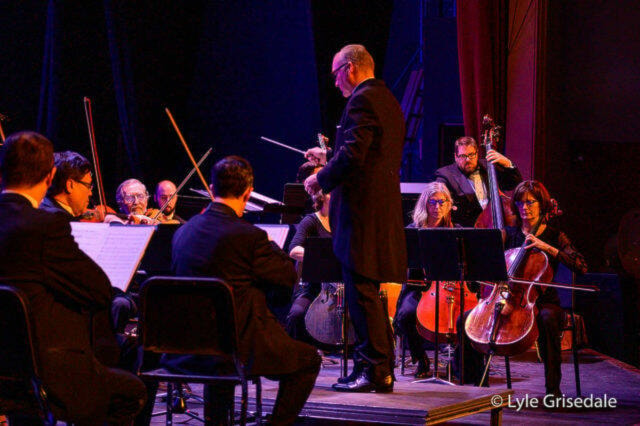By Yme Woensdregt
The last time the Symphony of the Kootenays played indoors was in February 2020. They were back this weekend to perform on Saturday night at the Royal Alexandra Hall. “Rejuvenation!” said the program, indicating how ecstatic they are to be back. The audience was equally ecstatic to have them back.
First up was Gustav Holst’s St. Paul’s Suite, a four–movement setting of English folk songs for string orchestra. From the very opening, the wonderfully live acoustic of the Royal Alex showed the orchestra off to full effect. The opening Jig revealed a rich, full sound. The orchestra dove into the music, with crisp rhythms and soaring melodies. The finale featured two tunes which have become famous, including a haunting “Greensleeves” sung by the cellos.
The second piece was Nino Rota’s Sonata for Chamber Orchestra. The contemporary Italian composer is best known for his film scores, such as Romeo and Juliet, La Dolce Vita, and most famously, The Godfather.
Woodwinds joined the strings on stage for this playful and tuneful three–movement work. Each musician was highlighted in the work. As Scott Wilson, principal horn of the Okanagan Symphony, has said, “the offers each instrument its moment in the brilliant sunshine.” Our musicians rose to the challenge and shone. The final movement evoked a village fair in my mind, with strings and winds playing off against each other in a wonderful dance–like movement which celebrates the joy to be found in life.
The Valse triste (“Sad Waltz”) by Jean Sibelius was originally part of the incidental music for Kuolema, a play by his brother–in–law. In this dark, foreboding waltz, the emphasis needs to be placed squarely on the “triste” in the title. Again, the orchestra played beautifully with a rich, full sound as they reflected on the dance of life and death.
A complete contrast came with Mozart’s Symphony 24. This very brief symphony—only 10 minutes long—was joyful, delightful, life–affirming. Melody flows out of Mozart just as a spring freshet flows from the melting ice in the spring, dancing in the newly–warming sunlight of the spring melt. I remember a scene from the movie “Amadeus”, in which Mozart’s rival Salieri marvels, “How does he do it? The melody comes from nowhere and lifts us to the ethereal realms where we can almost see God.”
The concert closed with a rousing rendition of what conductor Jeff Faragher called “the equivalent of a popular rock song of the day”, Beethoven’s Turkish March.
The concert was a triumph. For many of us, it was soul–restoring. The last year and a half has been a time of sorrow and sadness, and being able to attend a concert again seemed like a dream for us.
